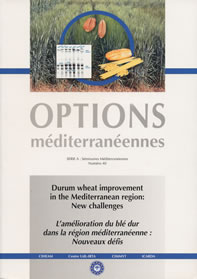| Article précédent | p. 387-392 | Article suivant |
Multiple disease resistance in durum wheat (Triticum turgidum L. var. durum)
Host plant resistance plays a major role in reducing losses from disease; however, monoculture of a limited number of durum wheat varieties over large areas resulted in faster spread of diseases such septoria leaf blotch (Mycosphaerella graminicola ) in North Africa, and yellow rust (Puciinia striiformis f.sp.tritici) in West Asia. The identification of durable sources of resistance to the prevalent durum wheat diseases is an important objective of the CIMMYT-ICARDA Durum Wheat Improvement Program for the Mediterranean region. In West Asia and North Africa (WANA) region, resistance to rusts, septoria leaf blotch, and tan spot is essential. Virulence analysis of leaf rust (Puccinia recondita) showed that ten 'Lr' resistance genes (Lr1, Lr2a, Lr9, Lr15, Lr19, Lr24, Lr25, Lr26, Lr28, and Lr29) were effective on bread wheat, six on durum wheat (Lr1, Lr2a, Lr20, Lr25, Lr26, and Lr30), and six among these 'Lr' genes were effective on both crop species.
- [ Afficher ]
- [ Télécharger ]
- [ Exporter la citation ]
Vous pouvez télécharger la citation au format :
- [ Imprimer ]
-
Mots-clés
AFRIQUE DU NORD, BLE DUR, MALADIE DES PLANTES, MOYEN ORIENT, POUVOIR PATHOGENE, RESISTANCE AUX MALADIESCiter cet article
Yahyaoui A., Al Naimi M., Nachit M., Hakim S. Multiple disease resistance in durum wheat (Triticum turgidum L. var. durum). In : Royo C. (ed.), Nachit M. (ed.), Di Fonzo N. (ed.), Araus J.L. (ed.). Durum wheat improvement in the Mediterranean region: New challenges . Zaragoza : CIHEAM, 2000. p. 387-392. (Options Méditerranéennes : Série A. Séminaires Méditerranéens; n. 40). Seminar on Durum Wheat Improvement in the Mediterranean Region: New Challenges, 2000/04/12-14, Zaragoza (Spain). http://om.ciheam.org/om/pdf/a40/00600063.pdf



